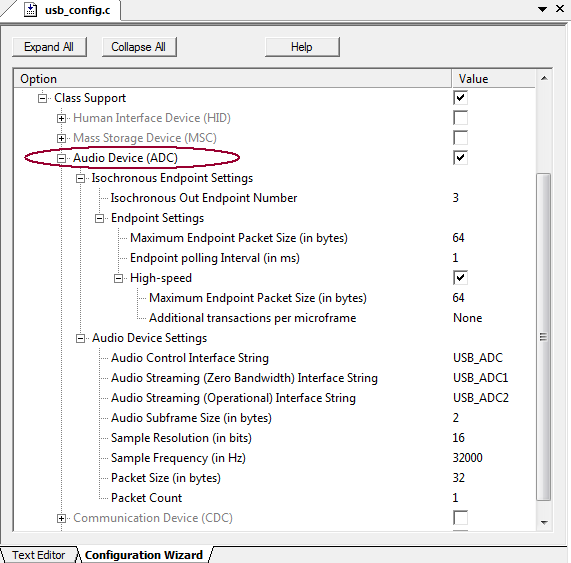|
||
| Products Download Events Support Videos | ||
Technical Support
On-Line Manuals
RL-ARM User's Guide (MDK v4)


 Audio Device (ADC) Options
Audio Device (ADC) Options
Audio Device (ADC) Options explains the configuration options for an audio device. The options can be edited in the file usb_config.c directly or using the µVision Configuration Wizard.

Where
-
Audio Device (ADC) - enables the USB audio functionality
of the device. This option corresponds to
#define USBD_ADC_ENABLE.
#define USBD_ADC_ENABLE 1 // 1=enabled; 0=disabled
Isochronous Endpoint Settings
configure the endpoint characteristics and affect Endpoint Descriptor.
configure the endpoint characteristics and affect Endpoint Descriptor.
-
Isochronous Out Endpoint Number sets the endpoint
number. Values between 1..15 are allowed. This option
corresponds to #define USBD_ADC_EP_ISOOUT.
#define USBD_ADC_EP_ISOOUT 0 // value range 1..15
-
Maximum Endpoint Packet Size (in bytes) sets the maximal
packet size. Values between 0..1024 are allowed. This option
corresponds to #define USBD_ADC_WMAXPACKETSIZE.
#define USBD_ADC_WMAXPACKETSIZE 64 // value range 0..1024
-
Endpoint polling Interval (in ms) sets the data transfer
polling interval. Discrete values can be selected. This option
corresponds to #define USBD_ADC_BINTERVAL.
#define USBD_ADC_BINTERVAL 1 // value range 0..1024
-
High-speed enables the characteristics when using high
speed transfer rates. Enable the High Speed option under
USB Device. This
option corresponds to #define USBD_ADC_HS_ENABLE.
#define USBD_ADC_HS_ENABLE 1 // 1=enabled; 0=disabled
-
Maximum Endpoint Packet Size (in bytes) sets the maximal
packet size for high speed transfers. Values between 0..1024
are allowed. This option corresponds to
#define USBD_ADC_HS_WMAXPACKETSIZE.
#define USBD_ADC_HS_WMAXPACKETSIZE 64 // next option also configures this macro
-
Additional transactions per microframe sets the
additional transaction packets for high speed transfers.
Discrete settings can be selected. This option also corresponds
to #define USBD_ADC_HS_WMAXPACKETSIZE.
#define USBD_ADC_HS_WMAXPACKETSIZE 64 // prev. option also configures this macro
Audio Device Settings
configure device specific options.
configure device specific options.
-
Audio Control Interface String sets the audio control
string identifier. 126 characters are allowed. This option
corresponds to #define USBD_ADC_CIF_STRDESC.
#define USBD_ADC_CIF_STRDESC L"USB_ADC" // up to 126 characters
-
Audio Streaming (Zero Bandwidth) Interface String sets
the zero bandwidth streaming control string identifier. 126
characters are allowed. This option corresponds to
#define USBD_ADC_SIF1_STRDESC.
#define USBD_ADC_SIF1_STRDESC L"USB_ADC1" // up to 126 characters
-
Audio Streaming (Operational) Interface String sets the
operational streaming control string identifier. 126 characters
are allowed. This option corresponds to
#define USBD_ADC_SIF2_STRDESC.
#define USBD_ADC_SIF2_STRDESC L"USB_ADC2" // up to 126 characters
-
Audio Subframe Size (in bytes) sets the audio subframe
size. Values between 0..255 are allowed. This option
corresponds to #define USBD_ADC_BSUBFRAMESIZE.
#define USBD_ADC_BSUBFRAMESIZE 2 // value range 0..255
-
Sample Resolution (in bits) sets the bit resolution
size. Values between 0..255 are allowed. This option
corresponds to #define USBD_ADC_BBITRESOLUTION.
#define USBD_ADC_BBITRESOLUTION 16 // value range 0..255
-
Sample Frequency (in Hz) sets the sample frequency.
Values between 0..16777215 are allowed. This option corresponds
to #define USBD_ADC_TSAMFREQ.
#define USBD_ADC_TSAMFREQ 32000 // value range 0..16777215
-
Packet Size (in bytes) sets the size of data packets.
Values between 1..256 are allowed. This option corresponds to
#define USBD_ADC_CFG_P_S.
#define USBD_ADC_CFG_P_S 32 // value range 1..256
-
Packet Count sets the number of data packets. Values
between 1..16 are allowed. This option corresponds to
#define USBD_ADC_CFG_P_C.
#define USBD_ADC_CFG_P_C 1 // value range 1..16
 Note
Note
- The USB Device Controller hardware might impose restrictions on the use of endpoints.
- Refer to Create ADC Applications for a quick-start on programming an audio device.
ProductsDevelopment Tools |
Hardware & Collateral |
Downloads |
Support |
Contact |
